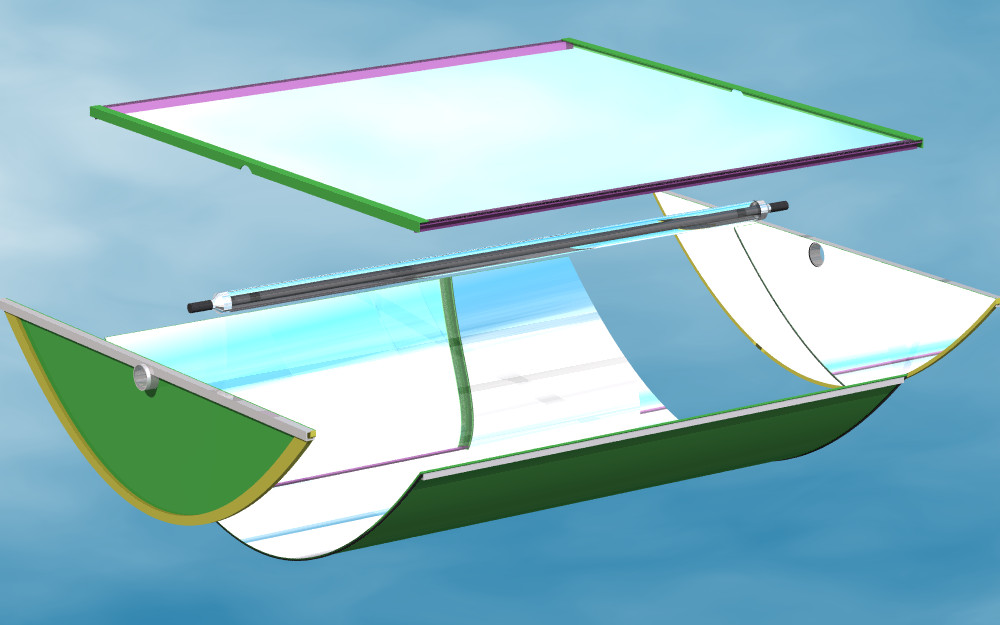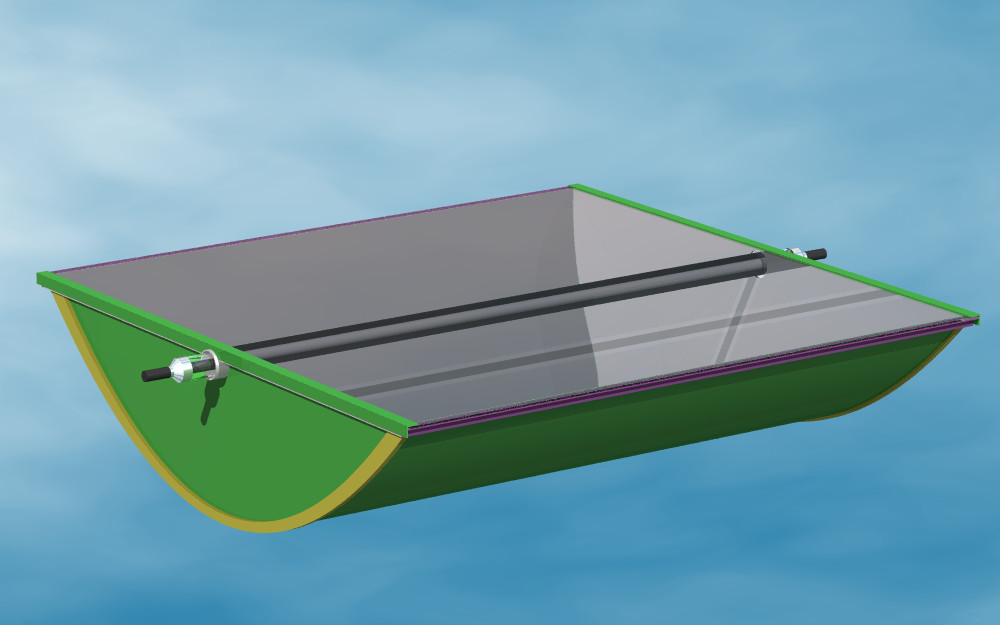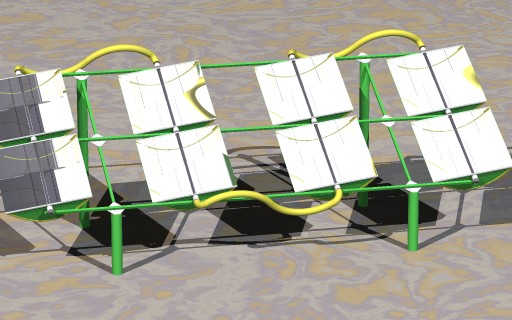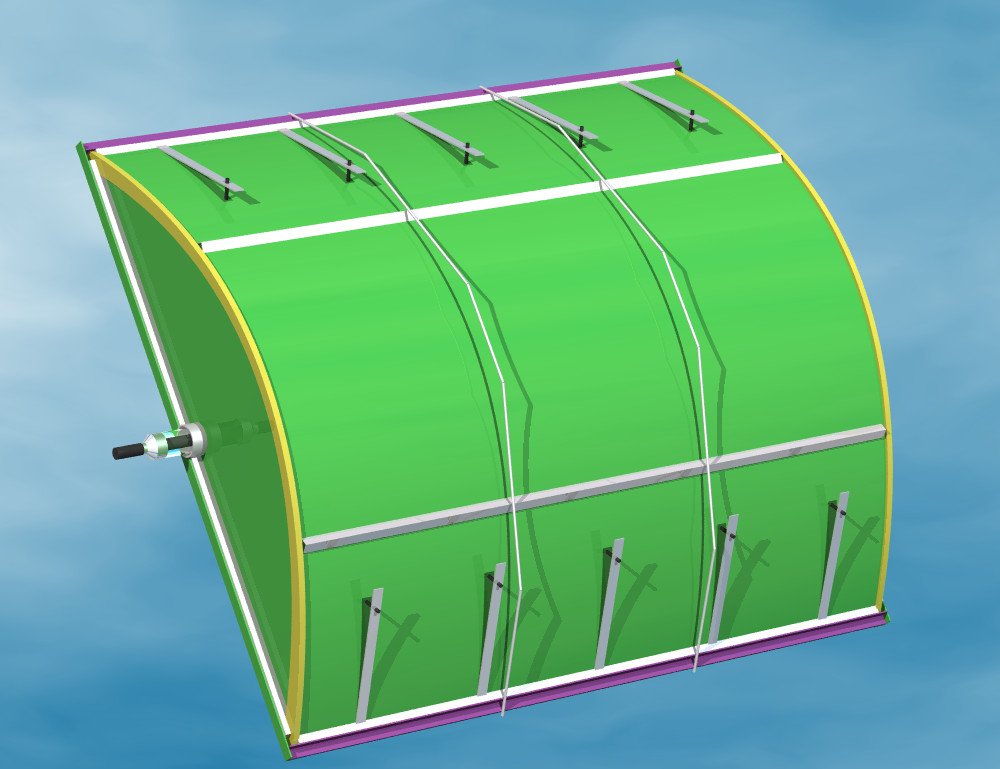
It is a small-size concentrating solar collector, with a reflective mirror surface under the form of a parabolic cylinder which concentrats the sunlight to a receiver tube located at the focus line. It is sold as a disassembled flat kit at very low prices. The kit can be assembled and installed by the user, much in the same way as most pieces of modern furniture. How to buy.

Once assembled, the collector is a closed box formed by a transparent cover, a curved back and two flat endplates. It will be water-tight, protecting the internal surfaces against rain, snow, dust, humidity and atmospheric pollutants. This guarantees a very long service life of the box.

The assembled collectors can now be mounted on a chassis, which in turn is fixed on the ground, ontop of a roof, on a vertical wall, etc.

The reflective surface of the collector is formed using the natural elasticity of the back plate. This is not exactly the surface we want; therefore the surface is redressed to correct the errors, with redressing mechanisms behind the back of the box. Note that we are not using pre-formed ribs.

These redressing mechanisms allow users to readjust the collector should any deformation occur after a few years of service. This is in general not necessary, and the collectors will come pre-adjusted in factory. For those who are interested in doing so, the DIY document contains a detailed account of the adjustment method.
The collector accepts 3 types of interchangeable receiver tubes.
Non-insulated low-temperature receiver. This is a simple metal tube, painted black or covered by a selective absorption layer. For low-temperature applications such as water heating, space heating, pool heating or absorption air conditionning, It offers the best global efficiency of up to 80%. It is also the most economic receiver.
Quality standard: absorptivity >93%, emissivity <25%, total thermal loss <35W/m2 at ΔT = 50°C.
Photovoltaic receiver. This is a metal tube covered at the outside by a layer of photovoltaic cells. When put under the focus, the photovoltaic cells receive concentrated light and generate electricity with a much higher output rate than non-cencentrated cells. The concentrated light also creates much heat within the cells, which is transmitted through the wall of the tube to water circulating within the tube. The heated water is then collected and used for water heating, space heating or pool heating.
This is therefore a combined heat and power generation mode. Besides the extra heat, the concentrated operating mode also divides the cost of the photovoltaic cells by a factor of 10 or more, for the same output power.
Quality standard: to be determined
Evacuated receiver. As shown above in the pictures, the metal tube is put within a transparent glass tube of much larger diameter. The annular space between the tubes is half-evacuated and filled with a low-pressure low-conductivity inert gas (see this). This receiver offers a reasonably low heat loss when operating at a high temperature up to 350°C. The overall efficiency of the collector will be lowered to 55-70%.
Quality standard: absorptivity >90%, emissivity <15%, total thermal loss <100W/m2 (Argon-filling) or <60W/m2 (xenon-filling) at 350°C; <65W/m2 (argon-filling) at 250°C.
| Concentration ratio | 40-100 |
| Life expectancy | 18 years |
| Overal efficiency | 55%-80% |
| Operating temperature | Up to 350°C |
| Resistance to wind | >150km/h |
| Resistance to hail | Data missing (very high) |
| Resistance to snow | 75kg/m2 (0.5m thick at 15% density) |
| Photodetector working range | 62° in each direction |
| Maximal solar angle with respect to cover normal dir. | 65° |
| Environment temperature | -10°C to 50°C |
The optical efficiency and thermal loss depends on the receiver used. In general, the closed box is 40% more efficient than the classical big parabolic trough.
The concentration ratio of the collector is the ratio between the width of the reflective surface and the diameter of the receiver tube. Although the collector can support a very high concentration ratio if well-adjusted, this ratio is better optimised according to the application. We give the following recommendations.
| Application | Optimal ratio |
|---|---|
| Residential use up to 100°C | 50 |
| Photovoltaics | 40-60 |
| Residential use, 200-280°C | 60 |
| Regional power plant, 350°C | 70-80 |
| Desert power plant, 350°C | 100 |
You can find discussions about the product in the project forum.
| Back to home | Gang Xiao |